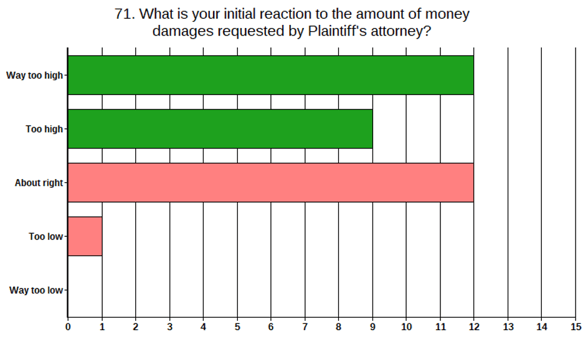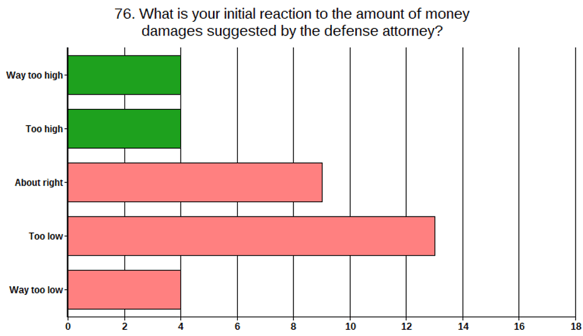.png?width=545&height=307&name=Beige%20Brown%20Thank%20You%20for%20Watching%20fashion%20and%20beauty%20(1920%20x%201080%20px).png)
In Week Two of our series on Robert Tyson’s Nuclear Verdicts, we delve into the concept of “giving a number” to the jury…by defense counsel. The mere suggestion that civil defense attorneys should offer the jury a damages number always sparks a lively conversation, and defense counsel have strong opinions on why they do not give a dollar amount to the jury. Many defense attorneys may be hesitant to propose a defense number if they believe their client is not liable, or perhaps they are concerned the number could be offensive in comparison to the high number given by Plaintiff’s counsel, or maybe they just don’t know the value of their own case. Whatever reasons defense attorneys have, failure to give a defense number usually ends up as Tyson describes: with the jury awarding “‘nuclear verdicts,’ based on fear and emotion, not evidence or the law.”1 Why are attorney's recommended damage numbers so impactful? Tyson talks about the psychological concepts of priming and of “primacy and recency.” In their article “Priming the Jury for Success,” Horres and Stanton define “priming” as a tool “used by counsel during voir dire to help advance their client's cause in unconscious ways.” Plaintiff’s ability to give the number first, as well as early and often, is why defense counsel should almost always employ Tyson’s strategy of “Always Give a Number.” Once the jury becomes “primed by repeatedly hearing the plaintiff’s requested damages number,” they are more likely to return a verdict “close to the plaintiff’s number.”2 Since plaintiffs present first and are accustomed to talking about money in front of the jury, they are able to anchor the jury to their number in voir dire and in opening statements.
Anchoring is a cognitive bias that describes the tendency for people to rely too heavily on the first piece of information they receive when making decisions or judgments. The use of anchoring by attorneys has a strong effect on jurors. When attorneys provide an anchor number, it influences the jurors' perception of what is reasonable or appropriate in terms of damages; the anchor number then becomes the reference point against which jurors compare other pieces of information and evidence presented during the trial. We see this time and time again where the jury deliberations in our mock trials start with: “I was thinking ______ about the amount of money they asked for?” Numerous studies have shown that anchoring can lead people to make judgments and decisions that are biased towards the initial anchor. This is because the anchor creates a mental high or low point that affects subsequent judgments.
Why is “anchoring” important with jury awards: “When we are faced with making a decision involving numbers, we tend to become stuck on the first number we see.”3 Seeing a high price first, you become more comfortable with high prices from then on.4 In the context of a trial, the defense attorney's anchor number can influence jurors to make a decision that is more favorable to the defense, by setting the standard for what is considered reasonable or appropriate under the circumstances.5
Defense attorneys choosing to give an anchor number may benefit in several ways:
- Establishing credibility: By suggesting a damage award based upon actual evidence and real dollars, you will appear more reasonable and credible to the jury. This can help to build trust with the jury, allowing you to become the leader in the courtroom.
- Reshaping perceptions: The anchor number can also shape the jury's perception of what constitutes a reasonable outcome. By providing a number that is lower than what the plaintiff is requesting, the defense can make the plaintiff's request seem unreasonable or excessive. Remember, jurors don’t always have the education and experience to know what the case they are hearing is worth. Jurors may perceive that the harm suffered by the plaintiff is severe, and therefore a high damages award is necessary to compensate them for their losses. They rely on their own perceptions of fairness and justice, influenced by sympathy for the plaintiff or anger towards the defendant. Jurors hear of recent billion dollar lottery wins and athlete’s multi-million dollar contracts, and those numbers begin to seem realistic to them.
- Reframing damages: By suggesting a lower number, the defense can attempt to mitigate the amount of damages where the plaintiff is requesting a very high amount of damages that is not supported by the evidence. Even if the defense attorney believes their client is not liable, proposing a defense number can still be a valuable tool in achieving a favorable outcome for the defendant.
Let’s look at an example of “Always Give a Number.” Consider the jurors’ responses in a recent First Court mock trial of an automobile accident where jurors were asked their initial reaction to Plaintiff’s request for $40,000,000.00 in damages.

Almost one-third of the jurors thought that $40 million dollars was “about right” to award Plaintiff for her injuries. Defense counsel later gave the jurors his anchor number of $500,000.00, connecting the amount to the medical bills and showing what that amount could do for the Plaintiff in real world dollars.

What happened when these jurors were asked the same question about the defense’s number? About half of the jurors now thought $500,000.00 was “about right, too high or way too high.” The defense counsel did not increase the amount of his anchor in response to the Plaintiff’s extraordinary number: He picked a number that he argued was reasonable for specific reasons and never increased it throughout the trial.

In this mock trial, the median total verdict was exactly what the defense counsel offered as the defense anchor. In their individual verdicts, only one mock juror awarded close to what the Plaintiff requested, and two jurors awarded Plaintiff nothing. Was this a defense win? Certainly. How did Defense counsel get the jurors to those numbers? He asked for it! Was that the only factor that caused the jurors to award significantly less than Plaintiff’s counsel requested? Of course not, but as Tyson tells us, “Don’t believe me, believe the science.”6
Countering a high plaintiff damages request requires a strategic approach based on a thorough analysis of the facts of the particular case. Sometimes the right defense number is $0. Utilizing a mock jury or focus group can give guidance on how a jury values the case. The success of these strategies will depend on the strength of the evidence presented, the persuasiveness of your arguments, as well as the jury who is awarding dollars. It seems counterintuitive and unnatural for most defense attorneys to give a damages number, but knowing you can present the most persuasive case before the jury should fuel the motivation to get uncomfortable and “Always Give A Number, Defense Counsel!”
Want more insights from First Court’s experience with jury verdicts? Check out our blog series on LinkedIn where we delve into Robert Tyson’s ten points one-by-one, drawing from the advice in his book while combining the thought leadership of prominent plaintiff and defense attorneys who have experienced both sides of a nuclear verdict. Keep an eye out for our upcoming Pain and Suffering: the third article in our series about preventing #nuclearverdicts.
Recent Articles by Our First Court Team:
- How to Avoid “Nuclear Verdict” Nightmares
- Always Accept Responsibility
- A Trial Lawyer’s Guide to Serving Red Herring
- Strategies for Gaining Credibility During Voir Dire.
- Tyson Jr., Robert F. Nuclear Verdicts: Defending Justice for All (Law Dog Publishing, LLC., 2020).
- Tyson Jr., Robert F. Nuclear Verdicts: Defending Justice for All (Law Dog Publishing, LLC., 2020), 38.
- Cherry, Kendra. “How Anchoring Bias Psychology Affects Decision Making.” Very Well Mind, (2020).
- Kerry. “The Anchoring Effect: The Old Numerical Ball and Chain.” Beyond the Purchase, (2012).
- Christopher T. Stein & Michelle Drouin, “Cognitive Bias in the Courtroom: Combating the Anchoring Effect Through Tactical Debiasing,” 52 U.S.F. L. Rev. 393, 399-400 (2018).
- Tyson Jr., Robert F. Nuclear Verdicts: Defending Justice for All (Law Dog Publishing, LLC., 2020), 47.
Tags:
Jury Research
Aug 9, 2023 10:01:03 AM




Comments